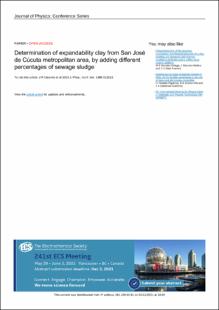Mostrar el registro sencillo del ítem
Determination of expandability clay from San José de Cúcuta metropolitan area, by adding different percentages of sewage sludge
| dc.contributor.author | caceres rubio, jose rafael | |
| dc.contributor.author | Rojas Suárez, Jhan Piero | |
| dc.contributor.author | Sanchez Molina, Jorge | |
| dc.date.accessioned | 2021-11-01T19:10:54Z | |
| dc.date.available | 2021-11-01T19:10:54Z | |
| dc.date.issued | 2019-11-19 | |
| dc.identifier.uri | http://repositorio.ufps.edu.co/handle/ufps/573 | |
| dc.description.abstract | This article shows the research carried out on clay from the San José de Cúcuta metropolitan area, Colombia, to which was added several percentages of a wastewater sludge, which is called as a technological nutrient. The objective of the study is to find out with what percentage of technological nutrient the capacity of expansion of the granules is maximized. The methodology that was followed consists of four phases; preparation of raw materials; pelletizing of raw materials in granules of 5 to 10 millimeters; application of heat treatment in a rotary kiln at the pilot plant level; and application of descriptive statistics for analysis of results. It was determined that the mixture with a 20% of technological nutrient, produces the highest volumetric expansion ratio, with 1.56 times its initial size, while, when adding 30% of the nutrient the same expansion occurs when adding an 10% nutrient, which is 1.07 times the initial size of the particle. | eng |
| dc.format.mimetype | application/pdf | spa |
| dc.language.iso | eng | spa |
| dc.publisher | Journal of Physics: Conference Series | spa |
| dc.relation.ispartof | Journal of Physics: Conference Series | |
| dc.rights | Content from this work may be used under the terms of theCreative Commons Attribution 3.0 licence. Any further distribution of this work must maintain attribution to the author(s) and the title of the work, journal citation and DOI. Published under licence by IOP Publishing Ltd | eng |
| dc.source | https://iopscience.iop.org/article/10.1088/1742-6596/1388/1/012013/meta | spa |
| dc.title | Determination of expandability clay from San José de Cúcuta metropolitan area, by adding different percentages of sewage sludge | eng |
| dc.type | Artículo de revista | spa |
| dcterms.references | Chandra S and Berntsson L 2002 Lightweight aggregate concrete (Norwich: Noyes Publications) | spa |
| dcterms.references | Holm T A and Ries J P 2007 Refer ence manual for the properties and applications of expanded shale, clay and slate lightweight aggregate (Chicago: ESCSI) | spa |
| dcterms.references | Cheeseman C R and Virdi G S 2005 Properties and microstructure of lightweight aggregate produced from sintered sewage sludge ash Resources, Conservation and Recycling 45 18 | spa |
| dcterms.references | Chiou I J, Wang K S, Chen C H and Lin Y T 2006 Lightweight aggregate made from sewage sludge and incinerated ash Waste Managemen 26 1453 | spa |
| dcterms.references | Cheeseman C R, Makinde A and Bethanis S 2005 Properties of lightweight aggregate produced by rapid sintering of incinerator bottom ash Resources, Conservation and Recycling 43 147 | spa |
| dcterms.references | Binyu Z and Poon C S 2015 Use of furnace bottom ash for producing lightweight aggregate concrete with thermal insulation properties Journal of Cleaner Production 99 94 | spa |
| dcterms.references | Lynn C J, Obe R K D and Ghataora G S 2016 Municipal incinerated bottom ash characteristics and potential for use as aggregate in concrete Construction and Building Materials 127 504 | spa |
| dcterms.references | Loutou M et al 2013 Phosphate sludge: thermal transformation and use as lightweight aggregate material Journal of Environmental Management 130 354 | spa |
| dcterms.references | Berg P W 1970 Investigation of leca-clay by the Technical University of Denmark Leca Internal Rep. 230 33 | spa |
| dcterms.references | Decleer J and Viaene W 1993 Rupelian Boom clay as raw material for expanded clay manufacturing Applied Clay Science 8 111 | spa |
| dcterms.references | R Core Team 2017 R: a language and environment for statistical computing (Vienna: R Foundation for Statistical Computing) | spa |
| dcterms.references | Ozguven A 2009 Genleşen kil agrega üretimi ve endüstriyel olarak değerlendirilmesi (Isparta: Süleyman Demirel University) | spa |
| dc.coverage.city | San Jose De Cùcuta | |
| dc.publisher.place | Reino Unido | spa |
| dc.relation.citationedition | Vol.1388 No.1.(2019) | spa |
| dc.relation.citationendpage | 7 | spa |
| dc.relation.citationissue | 1 (2019) | spa |
| dc.relation.citationstartpage | 1 | spa |
| dc.relation.citationvolume | 1388 | spa |
| dc.relation.cites | Cáceres, J. R., Rojas, J. P., & Sánchez, J. (2019, November). Determination of expandability clay from San José de Cúcuta metropolitan area, by adding different percentages of sewage sludge. In Journal of Physics: Conference Series (Vol. 1388, No. 1, p. 012013). IOP Publishing. | |
| dc.relation.ispartofjournal | Journal of Physics: Conference Series | spa |
| dc.rights.accessrights | info:eu-repo/semantics/openAccess | spa |
| dc.rights.creativecommons | Atribución 4.0 Internacional (CC BY 4.0) | spa |
| dc.type.coar | http://purl.org/coar/resource_type/c_6501 | spa |
| dc.type.content | Text | spa |
| dc.type.driver | info:eu-repo/semantics/article | spa |
| dc.type.redcol | http://purl.org/redcol/resource_type/ART | spa |
| oaire.accessrights | http://purl.org/coar/access_right/c_abf2 | spa |
| oaire.version | http://purl.org/coar/version/c_970fb48d4fbd8a85 | spa |
| dc.type.version | info:eu-repo/semantics/publishedVersion | spa |










